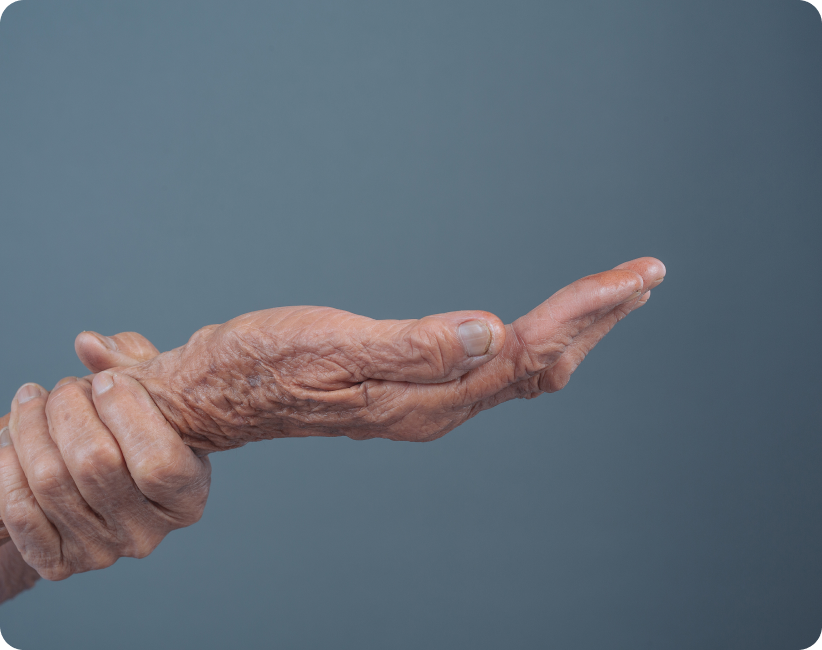

What are Essential Tremors?
Essential Tremor is a neurological disorder characterized by involuntary and rhythmic shaking. It is often mistaken for Parkinson’s Disease due to similarities in tremor symptoms, but detailed comparisons of Essential Tremor vs Parkinson's and Tremors vs Parkinson's reveal distinct characteristics. How do you know if you have Parkinson's or essential tremor? While ET typically affects the hands, it can also impact the head, voice, and other body parts, highlighting the difference between Parkinson's and essential tremor. Understanding these nuances is crucial in distinguishing Essential Tremor from Parkinson’s tremor.

What is Parkinson's Disease?
Parkinson's Disease is a progressive neurological disorder that impacts movement, marked by symptoms such as tremors at rest, stiffness, and bradykinesia (slowness of movement). When exploring Essential Tremor vs Parkinson's, a key difference between Parkinson's and essential tremor is evident: Parkinson’s Disease involves the degeneration of dopamine-producing neurons in the brain, a condition not associated with Eessential Tremor. This distinction is vital for accurate diagnosis and treatment.

Symptoms of Parkinson’s Disease and Essential Tremor
Symptoms of Parkinson’s Disease and Essential Tremor

Tremors during voluntary movements like eating or writing.

Tremors in the hands, head, and voice.

Worsening tremors with stress, fatigue, or caffeine.

Parkinson’s Tremors at rest, especially in the hands and legs.

Muscle stiffness and rigidity.

Slowness of movement (bradykinesia).

Balance and coordination problems.

Essential Tremor Treatment:
When comparing treatment approaches for Essential Tremors vs Parkinson's, Essential Tremor treatment aims to reduce the severity of tremors. Options include:
- Medications: Beta-blockers (e.g., propranolol) and anticonvulsants (e.g., primidone) are commonly prescribed.
- Lifestyle Changes: Reducing caffeine intake, managing stress, and using adaptive devices can help manage symptoms.
- Surgical Options: For severe cases, deep brain stimulation (DBS) or focused ultrasound may be considered
Types of Parkinson's Disease Symptoms:

Resting Tremors:
In Parkinson's Disease (PD), tremors frequently appear when the muscles are relaxed, such as when the hands rest on the lap, contrasting the symptoms of Essential Tremors where tremors occur during activity.

Bradykinesia:
This hallmark symptom of Parkinson’s Disease, characterized by slowness of movement, is often highlighted when discussing the Parkinson's vs Essential Tremor distinction.

Rigidity:
Stiffness in limbs and trunk, which can reduce the range of motion and cause pain, is a key symptom in Parkinson’s Disease but not a characteristic of Essential Tremor.

Postural Instability:
Challenges with balance and coordination, which heighten the risk of falls, are prevalent in Parkinson's Disease. These issues are distinct from Essential Tremors, where such symptoms are generally not observed, emphasizing the difference between Parkinson's vs Essential Tremor.
Types of Essential Tremors Symptoms:

Hand Tremors:
Essential Tremor (ET) commonly manifests with hand tremors that occur during activities such as writing, eating, or drinking, distinguishing it from discussions about Essential Tremor vs Parkinson's.

Head Tremors:
Characterized by a nodding or shaking motion of the head, this symptom is more typical in Essential Tremor than in Parkinson’s Disease (PD), highlighting the difference between Parkinson's and essential tremor.

Voice Tremors:
Essential Tremor may also cause a quivering voice during speech, which is a distinctive feature separating Essential Tremor from Parkinson’s tremor.

Aggravating Factors:
Symptoms of Essential Tremor can be intensified by stress, fatigue, and stimulants like caffeine, further delineating the similarities between Parkinson’s and Essential Tremor in how external factors influence condition severity.
Understanding the Difference: Essential Tremor vs Parkinson's
Frequently Asked Questions
Essential Tremor (ET) does not lead to Parkinson’s Disease (PD). These are two distinct neurological conditions with different causes and progression patterns. Essential Tremor is primarily a motor disorder that results in rhythmic shaking during voluntary movements, such as writing or holding objects. In contrast, Parkinson’s Disease involves the progressive degeneration of dopamine-producing neurons in the brain, which causes Parkinson’s tremors at rest, stiffness, and slower movement. While both conditions involve tremors and can impact similar age groups, understanding the difference between Parkinson’s and Essential Tremor is crucial for diagnosis and treatment. Although some people with Essential Tremor may fear it will evolve into Parkinson’s Disease, current medical research confirms they are separate disorders. Recognizing this helps individuals seek the proper Essential Tremor treatment without unnecessary concern.
Essential Tremor (ET) flare-ups can be triggered by various lifestyle and environmental factors. Common triggers include emotional stress, physical fatigue, anxiety, caffeine intake, and certain medications. These factors can amplify the intensity of tremors during tasks like writing, eating, or holding objects. In contrast, Parkinson’s tremors are more consistent and tend to appear when muscles are at rest. The essential distinction between Essential Tremor and Parkinson's is in the timing and variability of symptoms. Essential Tremors are situational, and managing these triggers can significantly reduce their severity. By adjusting daily routines, limiting caffeine, practicing stress reduction techniques, and using assistive tools like Steadi-3, individuals can take greater control of their symptoms and maintain a more stable lifestyle. Recognizing your specific tremor triggers is a key step in personalized treatment.
Currently, there is no known cure for either Essential Tremor or Parkinson’s tremors. However, several effective treatments can help manage symptoms and significantly enhance quality of life. For Essential Tremor, medications such as beta-blockers or anti-seizure drugs are commonly prescribed to reduce tremor intensity. Surgical options like Deep Brain Stimulation (DBS) may be considered in severe cases. Additionally, lifestyle changes—such as reducing stress and caffeine—and non-invasive devices like Steadi-3, can provide real-time stabilization and symptom relief. Parkinson’s Disease typically requires more complex management involving medication (e.g., Levodopa), physical therapy, and sometimes surgery. Understanding the difference between Parkinson’s tremor and Essential Tremor is essential in choosing the right strategy. While a cure may not exist today, proactive treatment can help individuals lead functional and fulfilling lives.
Diagnosing the cause of hand tremors involves a comprehensive evaluation by a neurologist. This typically includes a detailed medical history, a physical examination, and possibly neurological imaging like MRI or DaTscan. The doctor will observe when the tremors occur—whether at rest or during activity—to distinguish Essential Tremor vs Parkinson's. Essential Tremor usually manifests during intentional movement (e.g., lifting a cup), while Parkinson’s tremors often appear when the muscles are relaxed. Additional symptoms such as muscle rigidity, slowed movement, or balance issues can indicate Parkinson’s Disease. Blood tests may also be used to rule out other conditions. An accurate diagnosis, including medication, therapy, or assistive devices, is vital for tailoring an effective treatment plan. Understanding the difference between Parkinson’s and Essential Tremor ensures the correct management path is taken early.
Essential Tremor is More Prevalent than People Think:
Essential Tremor affects about 4% to 5% of individuals over the age of 65, making it more common in this age group. Additionally, approximately 4% to 22% of Essential Tremor cases begin before the age of 20, typically starting as tremors in hands, and then progressing to affect multiple parts of the body simultaneously.

The Steadi-3, Your most convenient companion
Millions of people experience hand tremors caused by conditions such as Parkinson’s disease or Essential Tremor. These involuntary movements can complicate everyday tasks like eating, writing, or even holding a cup of coffee. The Steadi-3 provides a non-invasive, wearable solution that enhances your current treatment, offering relief when medications alone are insufficient.
Essential Tremor Treatment and Assistive Devices:
While some tremor medication and surgical options can alleviate Essential Tremor symptoms for some individuals, there is no cure for Essential tremor. Moreover, up to 30% of patients do not respond to the first-line treatment medications for Essential tremor. Fortunately, patients do have the option of taking advantage of anti-vibration gloves and hand tremor devices like our Steadi-3 glove, which has proven to reduce tremor amplitude by up to 85% in some users, providing significant improvement in daily activities and quality of life for patients.

Essential Tremors are More Common than Parkinson's Disease
Although Parkinson's disease is the more well-known condition, Essential Tremor are much more common, affecting approximately 1% of the global population and can increase to 4%-5% in individuals over the age of 65. In contrast, Parkinson's disease only affects about 1% of individuals above the age of 60.


